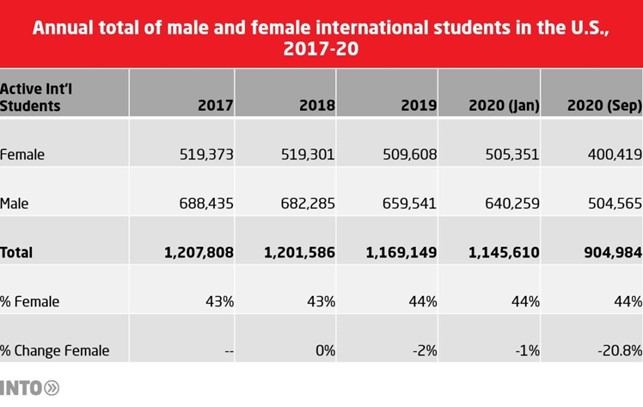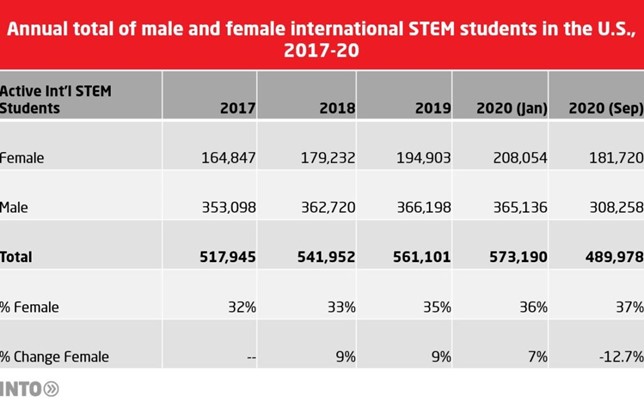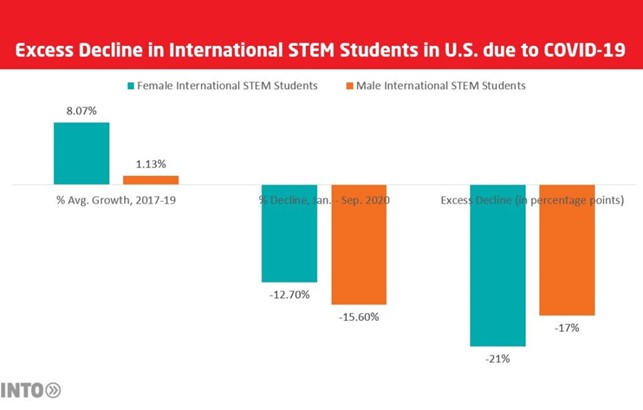Causes for celebration and concern: A three-year perspective on female international students in STEM at U.S. institutions

The global pandemic has had a disproportionate impact on female international students in STEM programs at U.S. institutions. According to data from the U.S. Student Exchange and Visitor Program (SEVP), the proportion of female international students in STEM fields in the U.S. grew to new heights in the three years leading up to the pandemic. However, SEVP’s post-pandemic data shows that COVID-19 has had a more significant negative impact on the number of female international students in STEM in the U.S. than it has on the number of their male peers.
When we last wrote on this topic, records from the Student Exchange and Visitor Information System (SEVIS) indicated there was a total of 1,207,808 international students in the U.S., of whom 519,373 (43%) were female. Between March 2017 and January 2020, as that total fell by 5.1%, the number of female international students fell at a slower rate than that of their male counterparts—a 2.7% dip for women compared to a 7% dip for men. The variation in rates of decline did not significantly affect the gender makeup of the international student cohort in the U.S. Women accounted for 44% of all international students by January 2020, just one percentage point more of the cohort than they made up in March 2017.

Source: SEVIS
Conversely, the number of international STEM students in the U.S. rose by 10.7% from March 2017, totaling 573,190 students by January 2020. During this period, the number of female international STEM students increased by 26.2%, versus a 3.4% increase in the number of male international STEM students. This significant climb resulted in a more gender-balanced international STEM student cohort in the U.S. than in previous years. Female international STEM students accounted for 36% of all international students in STEM programs at U.S. institutions by January 2020, compared to 32% in March 2017. Still, this measured progress does not negate the fact that male international STEM students in the U.S. still outnumbered their female peers nearly 2:1 in the three years before the pandemic.

Source: SEVIS
U.S. universities recorded unprecedented declines in their international student populations in fall 2020, with the total number of international students and international STEM students falling by 21% and 14.5%, respectively. Over the course of last year, the total number of female international STEM students decreased by 12.7%, compared to a 15.6% decrease in the total number of male international STEM students. Women came to make up 37.2% of all international STEM students in the U.S.
These figures suggest the most gender-balanced international STEM student cohort in the U.S. in the last three years, for which the number of women saw a less significant decline than the number of men. Relatively, however, COVID-19 caused greater declines in the total number of female international STEM students than in the total number of male international STEM students. From March 2017 to January 2020, the total number of female international STEM students in the U.S. increased by an average of 8.03%, versus an average of 1.13% for male international STEM students. The difference between this average and the 2020 figure represents an excess decline of 20.73 percentage points in the total number of female international students, compared to an excess decline of 16.73 percentage points in the total number of male international students.

Source: SEVIS
In the context of international STEM education in the U.S., the relative impact of COVID-19 differs between genders, and it comes down more significantly on women than on men. SEVP’s September 2020 data provides only an initial insight into the impacts of the pandemic, which means that COVID-19 may continue to have more significant negative consequences for female international students pursuing STEM studies, threatening pre-pandemic progress and widening the gender gap in science. It is on all of us in the international education sector, then, to commit to supporting women in science in recruitment efforts and teaching practices.